(完整版)状语从句在复合句中作状语
- 格式:docx
- 大小:16.28 KB
- 文档页数:3
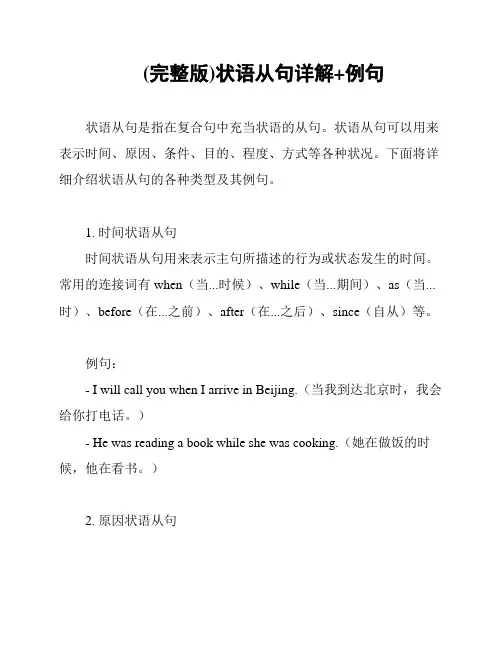
(完整版)状语从句详解+例句状语从句是指在复合句中充当状语的从句。
状语从句可以用来表示时间、原因、条件、目的、程度、方式等各种状况。
下面将详细介绍状语从句的各种类型及其例句。
1. 时间状语从句时间状语从句用来表示主句所描述的行为或状态发生的时间。
常用的连接词有when(当...时候)、while(当...期间)、as(当...时)、before(在...之前)、after(在...之后)、since(自从)等。
例句:- I will call you when I arrive in Beijing.(当我到达北京时,我会给你打电话。
)- He was reading a book while she was cooking.(她在做饭的时候,他在看书。
)2. 原因状语从句原因状语从句用来表示主句所描述的行为或状态的原因。
常用的连接词有because(因为)、since(因为)、as(由于)、for (因为)等。
例句:- I can't go to the party because I have to work.(我不能去参加派对,因为我得工作。
)- Since it is raining, we should stay at home.(由于下雨了,我们应该待在家里。
)3. 条件状语从句条件状语从句用来表示主句所描述的行为或状态的前提条件。
常用的连接词有if(如果)、unless(除非)、whether(无论)、provided(倘若)等。
例句:- If it rains tomorrow, we will stay indoors.(如果明天下雨,我们会呆在室内。
)- We can go shopping unless it is too late.(除非太晚,否则我们可以去购物。
)4. 目的状语从句目的状语从句用来表示主句所描述的行为或状态的目的。
常用的连接词有so that(以便)、in order that(为了)、lest(免得)等。
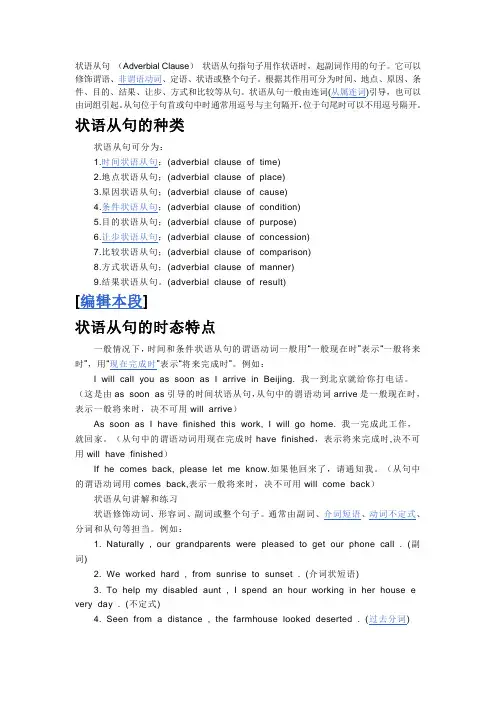
状语从句(Adverbial Clause)状语从句指句子用作状语时,起副词作用的句子。
它可以修饰谓语、非谓语动词、定语、状语或整个句子。
根据其作用可分为时间、地点、原因、条件、目的、结果、让步、方式和比较等从句。
状语从句一般由连词(从属连词)引导,也可以由词组引起。
从句位于句首或句中时通常用逗号与主句隔开,位于句尾时可以不用逗号隔开。
状语从句的种类状语从句可分为:1.时间状语从句;(adverbial clause of time)2.地点状语从句;(adverbial clause of place)3.原因状语从句;(adverbial clause of cause)4.条件状语从句;(adverbial clause of condition)5.目的状语从句;(adverbial clause of purpose)6.让步状语从句;(adverbial clause of concession)7.比较状语从句;(adverbial clause of comparison)8.方式状语从句;(adverbial clause of manner)9.结果状语从句。
(adverbial clause of result)[编辑本段]状语从句的时态特点一般情况下,时间和条件状语从句的谓语动词一般用“一般现在时”表示“一般将来时”,用“现在完成时”表示“将来完成时”。
例如:I will call you as soon as I arrive in Beijing. 我一到北京就给你打电话。
(这是由as soon as引导的时间状语从句,从句中的谓语动词arrive是一般现在时,表示一般将来时,决不可用will arrive)As soon as I have finished this work, I will go home. 我一完成此工作,就回家。
(从句中的谓语动词用现在完成时have finished,表示将来完成时,决不可用will have finished)If he comes back, please let me know.如果他回来了,请通知我。
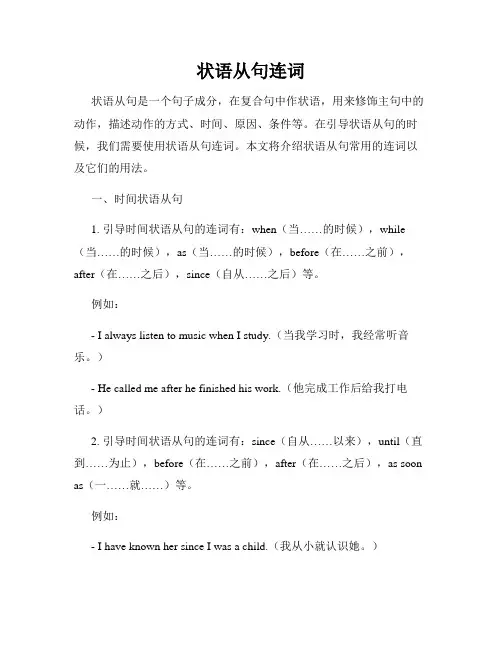
状语从句连词状语从句是一个句子成分,在复合句中作状语,用来修饰主句中的动作,描述动作的方式、时间、原因、条件等。
在引导状语从句的时候,我们需要使用状语从句连词。
本文将介绍状语从句常用的连词以及它们的用法。
一、时间状语从句1. 引导时间状语从句的连词有:when(当……的时候),while (当……的时候),as(当……的时候),before(在……之前),after(在……之后),since(自从……之后)等。
例如:- I always listen to music when I study.(当我学习时,我经常听音乐。
)- He called me after he finished his work.(他完成工作后给我打电话。
)2. 引导时间状语从句的连词有:since(自从……以来),until(直到……为止),before(在……之前),after(在……之后),as soon as(一……就……)等。
例如:- I have known her since I was a child.(我从小就认识她。
)- I will call you as soon as I arrive at the airport.(我到达机场后立即给你打电话。
)二、地点状语从句引导地点状语从句的连词有:where(在哪里),wherever(无论在哪里)。
例如:- He goes to the park where he can play basketball.(他去那个可以打篮球的公园。
)- You can find her wherever you go.(无论你去哪里都可以找到她。
)三、原因状语从句引导原因状语从句的连词有:because(因为),since(既然,因为),as(因为)。
例如:- She couldn't come to the party because she was busy.(她无法参加聚会,因为她很忙。
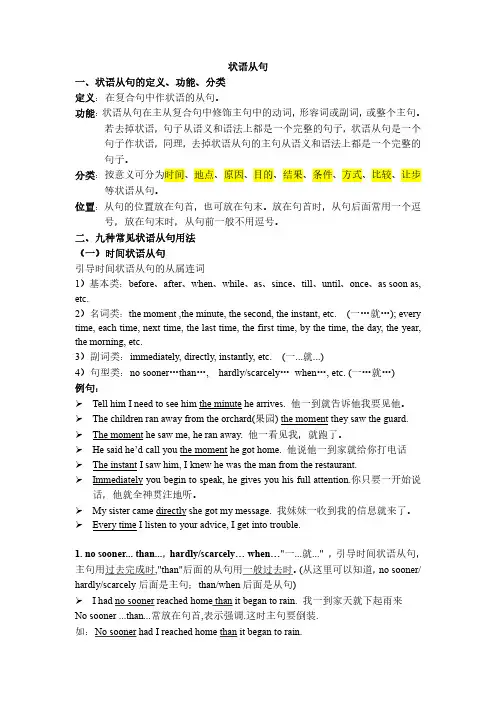
状语从句一、状语从句的定义、功能、分类定义:在复合句中作状语的从句。
功能:状语从句在主从复合句中修饰主句中的动词,形容词或副词,或整个主句。
若去掉状语,句子从语义和语法上都是一个完整的句子,状语从句是一个句子作状语,同理,去掉状语从句的主句从语义和语法上都是一个完整的句子。
分类:按意义可分为时间、地点、原因、目的、结果、条件、方式、比较、让步等状语从句。
位置:从句的位置放在句首,也可放在句末。
放在句首时,从句后面常用一个逗号,放在句末时,从句前一般不用逗号。
二、九种常见状语从句用法(一)时间状语从句引导时间状语从句的从属连词1)基本类:before、after、when、while、as、since、till、until、once、as soon as, etc.2)名词类:the moment ,the minute, the second, the instant, etc. (一…就…); every time, each time, next time, the last time, the first time, by the time, the day, the year, the morning, etc.3)副词类:immediately, directly, instantly, etc. (一...就...)4)句型类:no sooner…than…, hardly/scarcely…when…, etc. (一…就…)例句:Tell him I need to see him the minute he arrives. 他一到就告诉他我要见他。
The children ran away from the orchard(果园) the moment they saw the guard.The moment he saw me, he ran away. 他一看见我,就跑了。

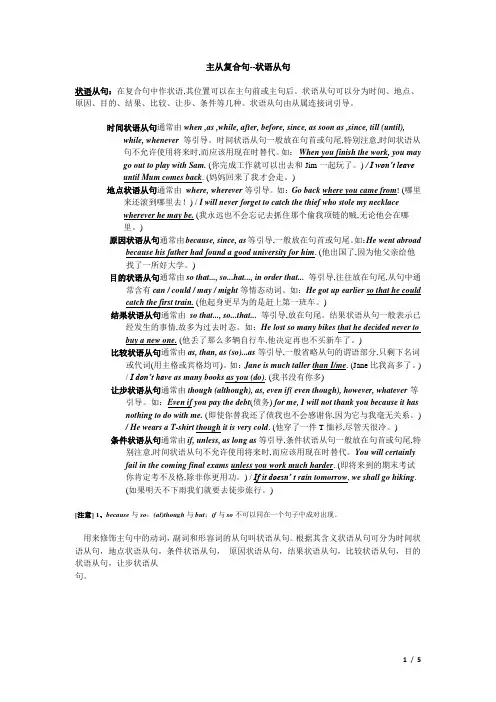
主从复合句--状语从句状语从句:在复合句中作状语,其位置可以在主句前或主句后。
状语从句可以分为时间、地点、原因、目的、结果、比较、让步、条件等几种。
状语从句由从属连接词引导。
时间状语从句通常由when ,as ,while, after, before, since, as soon as ,since, till (until), while, whenever等引导。
时间状语从句一般放在句首或句尾,特别注意,时间状语从句不允许使用将来时,而应该用现在时替代。
如:When you finish the work, you maygo out to play with Sam. (你完成工作就可以出去和Jim一起玩了。
) / I won’t leaveuntil Mum comes back. (妈妈回来了我才会走。
)地点状语从句通常由where, wherever等引导。
如:Go back where you came from! (哪里来还滚到哪里去!) / I will never forget to catch the thief who stole my necklacewherever he may be. (我永远也不会忘记去抓住那个偷我项链的贼,无论他会在哪里。
)原因状语从句通常由because, since, as等引导,一般放在句首或句尾。
如:He went abroad because his father had found a good university for him. (他出国了,因为他父亲给他找了一所好大学。
)目的状语从句通常由so that..., so...hat..., in order that...等引导,往往放在句尾,从句中通常含有can / could / may / might等情态动词。
如:He got up earlier so that he couldcatch the first train. (他起身更早为的是赶上第一班车。
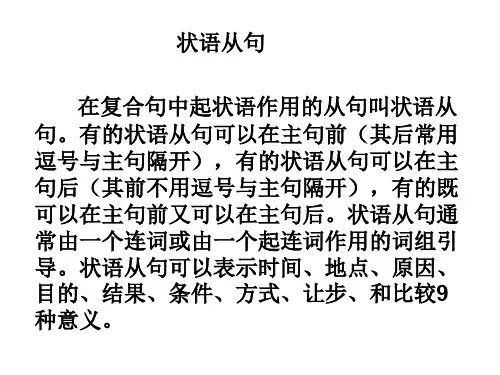

状语从句(Adverbial Clause)状语从句指句子用作状语时,起副词作用的句子。
它可以修饰谓语、非谓语动词、定语、状语或整个句子。
根据其作用可分为时间、地点、原因、条件、目的、结果、让步、方式和比较等从句。
状语从句一般由连词(从属连词)引导,也可以由词组引起。
从句位于句首或句中时通常用逗号与主句隔开,位于句尾时可以不用逗号隔开。
状语从句的种类状语从句可分为:1.时间状语从句;(adverbial clause of time)2.地点状语从句;(adverbial clause of place)3.原因状语从句;(adverbial clause of cause)4.条件状语从句;(adverbial clause of condition)5.目的状语从句;(adverbial clause of purpose)6.让步状语从句;(adverbial clause of concession)7.比较状语从句;(adverbial clause of comparison)8.方式状语从句;(adverbial clause of manner)9.结果状语从句。
(adverbial clause of result)[编辑本段]状语从句的时态特点一般情况下,时间和条件状语从句的谓语动词一般用“一般现在时”表示“一般将来时”,用“现在完成时”表示“将来完成时”。
例如:I will call you as soon as I arrive in Beijing. 我一到北京就给你打电话。
(这是由as soon as引导的时间状语从句,从句中的谓语动词arrive是一般现在时,表示一般将来时,决不可用will arrive)As soon as I have finished this work, I will go home. 我一完成此工作,就回家。
(从句中的谓语动词用现在完成时have finished,表示将来完成时,决不可用will have finished)If he comes back, please let me know.如果他回来了,请通知我。
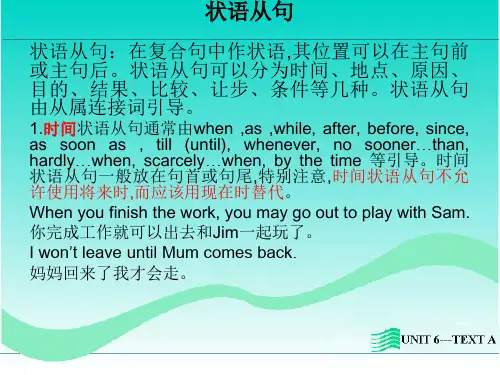
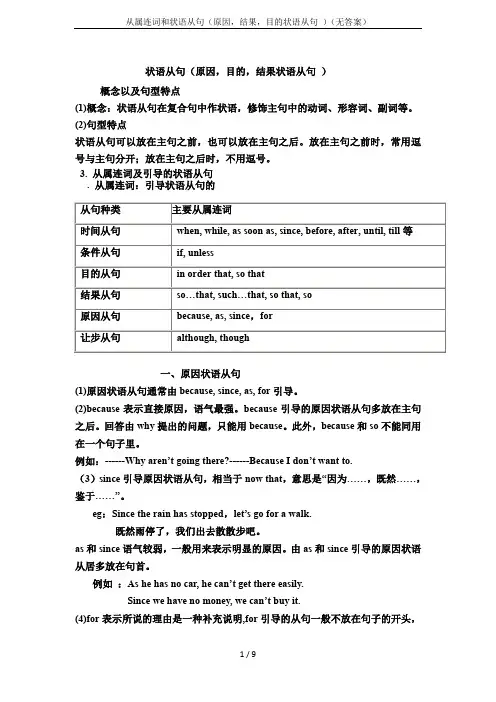
状语从句(原因,目的,结果状语从句)概念以及句型特点(1)概念:状语从句在复合句中作状语,修饰主句中的动词、形容词、副词等。
(2)句型特点状语从句可以放在主句之前,也可以放在主句之后。
放在主句之前时,常用逗号与主句分开;放在主句之后时,不用逗号。
3. 从属连词及引导的状语从句. 从属连词:引导状语从句的一、原因状语从句(1)原因状语从句通常由because, since, as, for引导。
(2)because表示直接原因,语气最强。
because引导的原因状语从句多放在主句之后。
回答由why提出的问题,只能用because。
此外,because和so不能同用在一个句子里。
例如:------Why aren’t going there?------Because I don’t want to.(3)since引导原因状语从句,相当于now that,意思是“因为……,既然……,鉴于……”。
eg:Since the rain has stopped,let’s go for a walk.既然雨停了,我们出去散散步吧。
as和since语气较弱,一般用来表示明显的原因。
由as和since引导的原因状语从居多放在句首。
例如:As he has no car, he can’t get there easily.Since we have no money, we can’t buy it.(4)for表示所说的理由是一种补充说明,for引导的从句一般不放在句子的开头,for引导的原因状语从句只能放于主句之后,并且必须用逗号将其与主句隔开。
:I decided to stop and have lunch, for I was feeling quite hungry.课堂随练用as,for ,sine,because填空1.I was late for class yesterday_____________ there was something wrongwith my bike.2.He took off his coat ___________ he felt hot.3.____________ you can’t answer the question, I’ll ask someone else.4._________he was ill, he didn’t go to school.5._______ you do not understand, I will explain again.6. ____she was late for class, she had to say sorry.7. He must be ill, _____he is absent today.8. I eat potatoes _________I like them.我吃土豆是因为我喜欢土豆。

完整版)状语从句(9种全)状语从句在复合句中起到修饰主句的作用,分为时间、地点、原因、目的、结果、条件、方式、比较、让步等种类。
1.时间状语从句时间状语从句的连接词包括when。
as。
while。
after。
before。
since。
ever since。
as soon as。
once。
till。
until。
whenever。
no sooner…than。
hardly/scarcely。
when。
the moment/minute/instant/second。
every time。
each time。
any time。
the first time。
next time。
last time。
all the time。
by the time。
directly。
immediately。
instantly等。
例如,“一···就···”的句型可以用as soon as或once引导,其中as soon as侧重时间或动作先后衔接紧,而once侧重条件,表示“一旦。
”;on doing sth/on one's + n.作时间状语,例如On arriving at the n。
the thief was arrested.意为“一到达车站,这个小偷就被逮捕了。
”2.地点状语从句地点状语从句的连接词包括where。
wherever。
anywhere。
everywhere等。
例如,I'll go wherever you go.意为“你去哪儿,我就跟你去哪儿。
”3.原因状语从句原因状语从句的连接词包括because。
since。
as。
now that。
seeing that。
considering that等。
例如,Since it's raining。
we'll stay indoors.意为“因为下雨,我们将待在室内。
状语从句在复合句中作状语,修饰动词、形容词或副词等。
状语从句可以表示时间、条件、原因、地点、目的、结果、让步、方式、比较等意义。
知识梳理:提纲挈领,抓住重点和难点!各类状语从句连接词(短语)一览表:时间when, while, as, as soon as, since, until, after, before条件If, unless原因As, because, since地点Where目的So that, in order that结果So that, so…that, such…that让步though, although, even if, however方式As比较than, (not)as…as,时间状语从句:Whenever he comes, he brings a friend. 他每次来都带个朋友。
条件状语从句:As long as I am alive, I will go on studying. 只要我活着,我就要学习。
原因状语从句:Since we live near the sea, we enjoy nice weather.由于我们住在海边,能享受到好的天气。
地点状语从句:Put it where we can all see it.把它放在我们都能看到的位置。
目的状语从句:Finish this so that you can start another.把这个做完,你可以开始另一个。
结果状语从句:He was so angry that he couldn't say a word. 他气得说不出话了。
让步状语从句:Though he is in poor health, he works hard.虽然他身体不好,但是他工作很努力。
方式状语从句:Students do as the teachers say.学生们按照老师说的去做。
比较状语从句:The work isn't as easy as I thought.这项工作比我想象得难。
(完整版)英语中状语从句用法及例句总结(完整)状语从句(Adverbial Clause)状语从句指句子用作状语时,起副词作用的句子。
它可以修饰谓语、非谓语动词、定语、状语或整个句子。
根据其作用可分为时间、地点、原因、条件、目的、结果、让步、方式和比较等从句。
状语从句一般由连词(从属连词)引导,也可以由词组引起。
从句位于句首或句中时通常用逗号与主句隔开,位于句尾时可以不用逗号隔开。
状语从句的种类状语从句可分为:1.时间状语从句;(adverbial clause of time)2.地点状语从句;(adverbial clause of place)3.原因状语从句;(adverbial clause of cause)4.条件状语从句;(adverbial clause of condition)5.目的状语从句;(adverbial clause of purpose)6.让步状语从句;(adverbial clause of concession)7.比较状语从句;(adverbial clause of comparison)8.方式状语从句;(adverbial clause of manner)9.结果状语从句。
(adverbial clause of result)[编辑本段]状语从句的时态特点一般情况下,时间和条件状语从句的谓语动词一般用“一般现在时”表示“一般将来时”,用“现在完成时”表示“将来完成时”。
例如:I will call you as soon as I arrive in Beijing. 我一到北京就给你打电话。
(这是由as soon as引导的时间状语从句,从句中的谓语动词arrive是一般现在时,表示一般将来时,决不可用will arrive)As soon as I have finished this work, I will go home. 我一完成此工作,就回家。
高三一轮语法回顾与训练---状语从句1.在复合句中作状语的句子叫状语从句。
状语从句在主从复合句中修饰主句中的动词、形容词、副词或整个主句。
按意义可分为时间、地点、原因、目的、结果、条件、方式、比较、让步等状语从句。
状语从句可放在句首,也可放在句末。
放在句首时,从句后面常用一个逗号;放在句末时,从句前一般不用逗号。
2.考点归纳一、时间状语从句1. when, while与as引导的时间状语从句(1)when, while与as引导时间状语从句的区别。
when 从句用的最多的是一般过去时,而主句的时态没有限制,根据具体情况而定。
while 从句的侧重点就不一样了。
while 从句的侧重点在于描述动作正在发生的状态,它的意思是:当while 事件正在发生的时候,另一件事如何如何。
所以,while 从句一般用的是正在进行时。
而另一件事的状态没有硬性的要求,根据具体情况而定。
as 从句表示的也是一件事情正在发生,另一件事也正在进行当中。
但与while 从句不同的是,as 从句用的一般不用正在进行时,而只是一般过去时。
as 从句一般可以翻译成“边……边……”。
When they heard the news that Shenzhou Ⅸ had been sent up into space successfully, they jumped with joy. 当听到神州九号成功发射的消息时,他们高兴地跳了起来。
When / While I was reading, he came in.(2)while还可以作并列连词,表示对比,意为“而;却”。
Liu Wang is from Shanxi while Liu Yang comes from Henan. 刘旺来自山西,而刘洋来自河南。
(3)when也可以作并列连词,意为“这时;那时”,常用于以下句式:→ be about to do…when…正要做…这时…→ be on the point of doing…when…正要做…这时…→ be doing…when…正在做…这时…→ had just done…when…刚做完…这时…We were having a meeting when someone broke in.2. before与since引导的时间状语从句(1)before常译为“在…之前;还未…就…;…才…;趁…;还没来得及…”。
状语从句在复合句中作状语, 修饰动词、形容词或副词等。
状语从句可以表示时间、 条件、原因、地点、目的、结果、让步、方式、比较等意义。
知识梳理:提纲挈领,抓住重点和难点! 各类状语从句连接词(短语)一览表: 时间条件 If, unless 原因 As, because, since 地点 Where 目的 So that, in order that 结果 Sothat, so …that, such …that 让步 though, although, even if, however 方式 As比较 than, (not)as … as, 时间状语从句:Whenever he comes, he brings a friend. 条件状语从句:As long as I am alive, I will go on studying. 原因状语从句:Since we live near the sea, we enjoy nice weather.由于我们住在海边地点状语从句:Put it where we can all see it.把它放在我们都能看到的位置。
当……时候#, 但用法有区别 :① when 意为#在……时;当……时#,可表示#点时间#或#段时间#,从句谓语可以是终止性动词,也可以是延续性动词。
例如:When I got home, he was having supper . ②as 意为#边••…边……#或#与••…同时#,重在表示两个动作同时发生。
伴随进行。
as 从句是终止性动词时,主句通常也必须是终止性动词。
例如 :They sang as they danced. ③while 只可表示#段时间#,从句谓语只限于延续性动词。
例如While I was sleeping, my father came in.注:从句谓语是持续性动词时,when 、while 和as 可以互换?主?从句谓语都是终止性动词时,when 与as 可互换?从句谓 语表示状态时 , 通常用 while 。
2. 引导原因状语从句的连词原因状语从句一般由 because , since , as , for 引导?注意 as ,because ,since 和 for 的区别 :① 如果原因是构成句子的最主要部分 ,一般用because 。
because 引导的从句一般不放在句子的开头。
例如:when, while, as, as soon as, since, until, after, before他每次来都带个朋友。
只要我活着, 我就要学习。
,能享受到好的天气。
目的状语从句:Finish this so that you can start another.结果状语从句:He was so angry that he couldn't say a word.让步状语从句:Though he is in poor health, he works hard.方式状语从句:Students do as the teachers say.比较状语从句:The work isn't as easy as I thought.状语从句的考查点 状语从句是中考词汇和句法部分考查的重点内容之一。
法。
现就主要考查点简述如下 :1.引导时间状语从句的连词主要有 when, while, as, by the time, before, after把这个做完,你可以开始另一个。
他气得说不出话了。
虽然他身体不好,但是他工作很努力。
学生们按照老师说的去做。
这项工作比我想象得难。
在复习状语从句时 ,主要任务是弄清楚引导各种状语从句的连词的用, since, till/until, as soon as 等。
其中 when?while 和 as 都可表示 #I missed the train because I got up late.注:对于以why 开头的问句,一般只能用because 引导的从句来回答。
②如果原因已为人们所知,或不如句子的其余部分重要,就用as或since、since比as稍微正式一些。
as和since引导的从句一般放在句子的开头。
例如:As he was not well,I decided to go there without him.Since this method doesn]t work, let]s try another .③for表示所说的理由是一种补充说明,因此,for引导的从句可以放在括号里,而且for引导的从句一般不放在句子的开头。
例如:I decided to stop and have lunch, for I was feeling quite hungry.3. 引导结果状语从句的连词主要有so/such …that …,so that 等。
1) so...that 结构在某种情况下可以与enough to 和too...to 结构相互转换。
例如:She is so short that she can]t reach the buttons of the lift. =She is too short to reach the buttons of the lift.2) so that 也可以引导结果状语从句,意为#结果是;以致于#。
例如:They missed the bus so that they were late for class.注:so that也可引导目的状语从句,此时可用to或in order to替换,将其改为简单句。
例如:He got up early so that he could get to school on time. =He got up early to get to school on time. =In order to get to school on time,he got up early.例题解析:举一反三,学的更轻松!易混引导词while, when, as 的区别:when既可以指”时间点",与瞬间动词连用,也可以指”时间段”,与延续性动词连用(=while )。
如:When he came in, his mother was cooking.When (While) we were at school, we went to the library every day.While 表示时间段,因此,while 从句的谓语动词要用延续性动词。
如:Please don't talk so loud while others are working.As与when用法相似,但着重强调主句动作与从句动作同时发生,有”随着……"或"一边……一边……"之意。
如:As you get older, you get more knowledge. 随着年龄的增长,你获得的知识就越多。
2.Because,as,since 的区别:Because用于表示直接原因,回答why提出的问题,语气最强;As用于说明原因,着重点在主句,常译成"由于";since 表示显然的或已知的理由或事实,常译成"既然"。
如:Water is very important because we can't live without it.He didn't come yesterday as his mother was ill.I'll do it for you since you are busy.3. such…that, so …that, so that 引导结果状语从句的区别:such 是形容词,修饰名词; so 是副词,修饰形容词或副词。
其结构如下:1) such + a (n)+ 形容词+单数可数名词+that ……2) such+ 形容词+复数可数名词+that ……3) such + 形容词+不可数名词+that ……。
如:This was such a good film that I went to see it several times.It was such good books that they sell well.It was such bad weather that I had to stay at home.He spoke so fast that I couldn't follow him.He is such a lovely boy that we all like him.=He is so lovely a boy that we all like him.注:在"形容词+可数名词复数/不可数名词"结构中,当名词前有many, much, few, little 量的多少时,名词前用so。
如:She made so many mistakes that she didn't pass the exam. 练习与巩固:熟能生巧,取得好成绩!选择合适的连接词,完成下列句子。
1. Jim spends a lot of money on books ____ he is not rich.2. Kate fell into sleep ___ she was listening to the music.3. -- Is David at school today?-- No. He is at home ____ he has a bad cold.4. We won't have supper ___ my mother comes back.5.Speak to him slowly _____ he may understand you better.6. ____ she doesn't come on Sunday, I'll go fishing by myself.7.It is four years _____ I had left that small village.8. _____ t he air moves, it is called wind.9. We will go to the park ____ it doesn't rain tomorrow.10. ____ l ittle boys did _____ much work.11. There are few new words in the passage ___ we can't understand it.12. Go back ____ you come from.13. He reached the station ____ the train had left.14. Do you have a swimming pool?--- No, we don't. At least, not ____ big ______ y ours.15. Give me your paper ___ you have finished it.16.It is raining hard, _____ we have to stay at home.17. ____ y ou work harder, you'll never pass the final exam.18. Look after te children ___ I am out.19. _______________ The village is __ far away I can't get there on foot.20. ___________ T hat is _______________ an interesting book I can't stop reading it.2.while3.because7. si nce 8.when12.where 13.before17.unless 18.while4. until5. sothat9.if 10.Such, do14.as(so), as 15.after19.so, that 20.such, that表示数Keys: 1.though6.Even if11.but16.so。